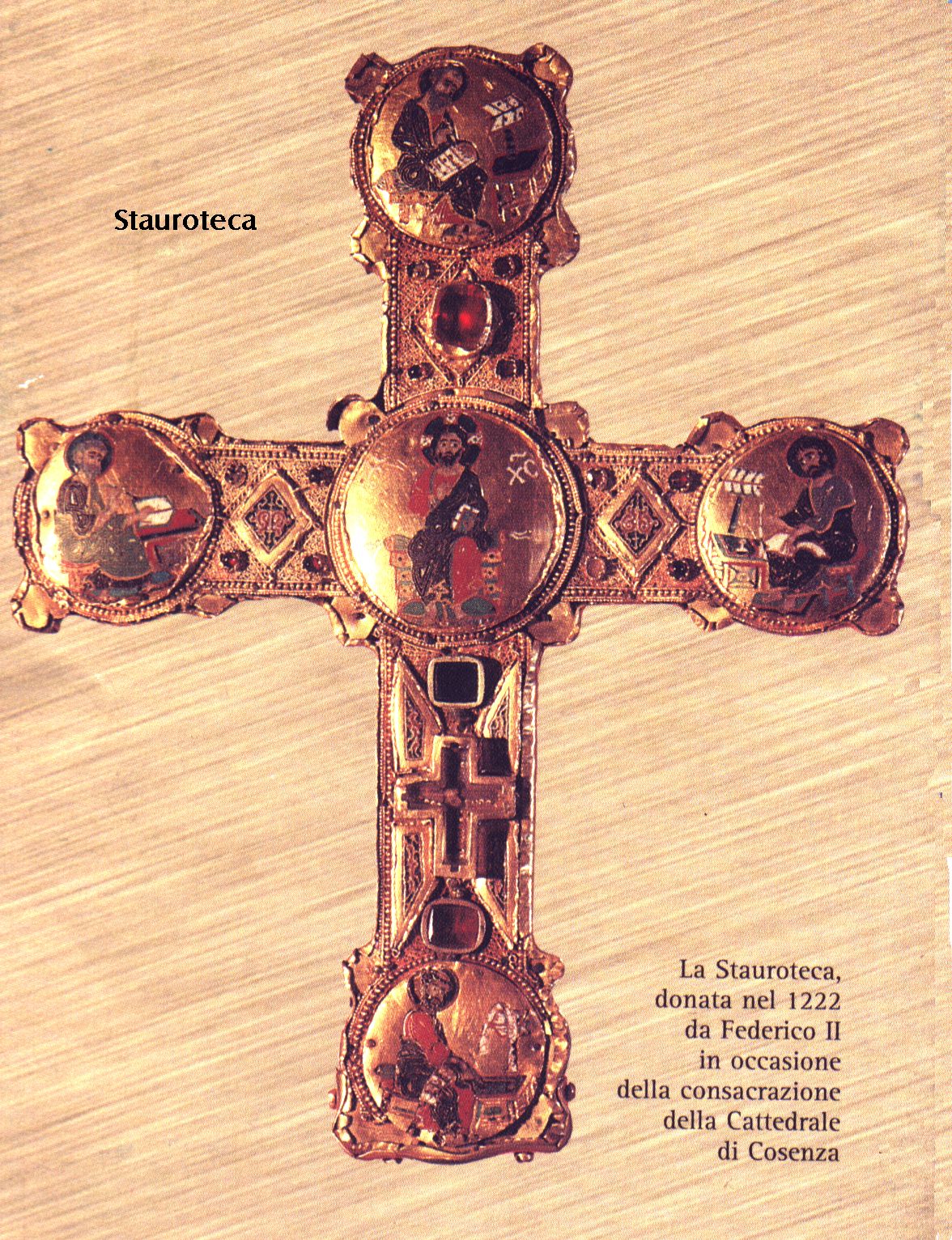Cosenza
Cosenza
Cosnza
The Castle 
The castle stands on the top of
Pancrazio Hill.
It was built by the Saracens on the ruins of the ancient Brutium
fortress.
Ruggero II of Altavilla, king of Sicily, improved the whole structure in
1130
but in 1184
a strong earthquake destroyed it.
Then,in 1239, the Swebian emperor
Frederic II addedd the castle two octagonal towers. The Angevins built the
upper floor and a chapeI,
while later the Aragonese used the
Castle as a mint, as an armery and
then as a prison. Another terrible
earthquake in 1638 and the new thechnologies in weapons and defence decreed the
end of the castle's greatness. During the 18th century the archbishop of COSENZA
built a seminary in the castle, while in the 19th century it became a
prison.  Stauroteca
Stauroteca
Probably built in the middle of
the 11th century, the Cathedral was destroyed by the earthquake of 1184. The
archbishop Luca Campano rebuilt it in Gothic-Cistercian form and in 1222 the
Cathedral was solemnly consacreted in the presence of the Swebian emperor
Frederic II.
During the 1 Sth century the neapolitan archbishop Michele Capece
Galeota restored the church covering the whole interior with baroque-style
decorations, while in the first half of the 19th century another neopolitan
archbishop,
Domenico
Narni Mancinelli, changed even the facade into baroque-style.
In the last years of the 19th
century the archbishop Camillo Sorgente restored the Cathedral giving it again
the simple character of medieval architecture.
The Madonna del Pilerio's Chapel and the one of
the brotherhood
"DeIl'orazione e morte" still keep their baroque style.
In the right aisle there is the
ancient sarcophagus of Meleagro which contains the mortal remains of Arrigo, one
of the sons of Federico II. In the transept is placed the monument in Isabella
d'Aragona's memory: she was the wife of the king of France Filippo III d'Angiņ;
this beautiful sculpture was carved out of our local stone by an unknown French
artist in 1271.
San Francesco D'Assisi's Church
It was founded in 1217 by the
Blessed Pietro Cathin upon the ruins of a Benedectine monastery destroyed by the
earthquake of 1148.In 1656 they rebuilt and restored it to repair the demages
caused by the earthquake of 1638.
During the next year they built the
Immacolata's Chapel in the place where the high altar of the Church once
stood.
The monastery
closed in 1866 and the Minor friars came back in 1912. The church has a Latin
cross shape with three naves;
the wooden carved high altar dates back to
the 18th century.
The altar of the Immacolata's chapel was carved out
of marble
by
Salvatore da Taverna in 1777.
Behind this altar there is the ancient apse
of'the church which dates back to the 13th century and has little
columns,
capitals
and cross-vaults cut out of our local stone in l400.
In this ancient apse we can also
admire a wooden choir
of 1505, a wooden crucifix of 1300 and the mortal remains
of the Blessed Giovanni da
Castrovillari.
Santa Caterina's ChapeI was built by the Migliarese
family.
In 1530 this
family gave it to santa caterina d'AIessandria's Brotherhood.The walls of the
chapel are enriched by beautiful pictureas showing the life of Santa Caterina,
painted by
the
Flemish painter W.Borremans in 1705.
The Church dates back to 1510. In
former times there was in its place
another Church
dedicated to the Madonna di Loreto.
Once in the Church we can admire several works
of art such as :
the bust in marble of Muzio de Gaeta
(1645), the monument in Ottavio
de Gaeta's
memory(1593), the famous picture by Pietro Negroni
"Madonna col bambino in gloria fra i santi Luca e Paolo"
(The glory of our Lady with Child amid St. Luke and St.Paul)
painted in 155l.
A triptych painted
by Cristoforo Faffeo in the first years of 1500 is over
the high altar : it represents a "Madonna col bambino fra S.Sebastiano
e
S.Caterina d Alessandria".
Behind the altar there is a wooden choir carved by Domenico
Costanzo da RogIiano in 1768.